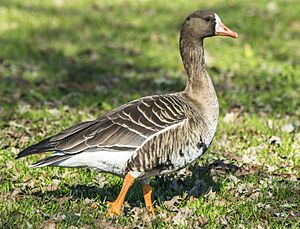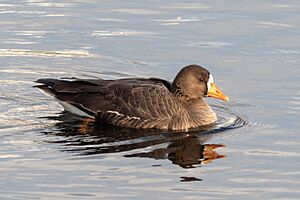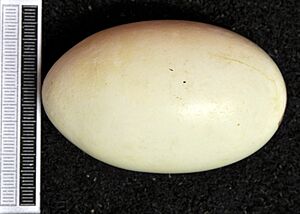Greater white-fronted goose facts for kids
The greater white-fronted goose (Anser albifrons) is a type of goose. It is closely related to the smaller lesser white-fronted goose. These geese are known for the white patch of feathers on their face, right above their beak. This is where the name "white-fronted" comes from!
Quick facts for kids Greater white-fronted goose |
|
|---|---|
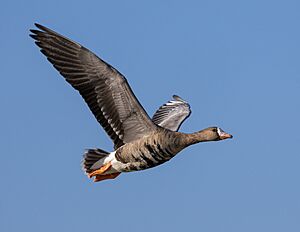 |
|
| A greater white-fronted goose during migration in the Central Valley of California | |
| Conservation status | |
| Scientific classification | |
| Genus: |
Anser
|
| Species: |
albifrons
|
| Subspecies | |
|
|
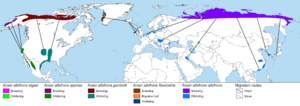 |
|
| Distribution map of subspecies of greater white-fronted goose | |
| Synonyms | |
|
Branta albifrons Scopoli, 1769 |
|
These geese are migratory. This means they fly long distances between their breeding and wintering grounds. They breed in northern Canada, Alaska, Greenland, and Russia. Then, they fly south to spend the winter in North America, Europe, and Asia.
A cool feature of adult greater white-fronted geese is their chest. It has unique "salt-and-pepper" markings. Because of these markings, people in North America often call them "specklebellies."
Contents
What Do Greater White-Fronted Geese Look Like?
Greater white-fronted geese are medium-sized birds. They are about 25 to 32 inches (64 to 81 cm) long. Their wings can spread out to about 51 to 65 inches (130 to 165 cm). They usually weigh between 4 and 7 pounds (1.9 to 3.3 kg).
These geese have bright orange legs. Their upper wings are a mouse-like gray color. They are smaller than greylag geese.
Both male and female geese look very similar. They are grayish-brown birds. Their chests are light gray with dark brown or black spots and bars. Both sexes also have a pinkish beak and orange legs and feet.
Greater white-fronted geese make a high-pitched cackling sound. It sounds a bit like "he-he." There is a clear break in the sound between the first and second cackle.
Differences in Goose Subspecies
There are different types, or subspecies, of white-fronted geese. The European or Russian white-fronted geese (called albifrons) look a bit different from the Greenland white-fronted geese (called flavirostris). The Greenland geese spend winter in the British Isles.
Greenland white-fronted geese look darker. They also look more "oily" than the European and Asian types. This is true whether they are resting or flying.
Here are some ways they look different, especially when they are young:
- The upper back feathers of Greenland geese look smooth. European geese have more noticeable white edges on these feathers, making them look striped.
- The wing feathers of Greenland geese have faint pale edges. On European geese, these edges are much clearer.
- The wing-coverts (feathers covering the main wing feathers) of Greenland geese are dark gray. They have a thin white tip. European geese have blue-gray wing-coverts with bold white tips. This creates clear wing-bars.
- The white line on the side of the body is thin on Greenland geese. It is wide and bright white on European geese.
- The tail of Greenland geese is dark brown with a very thin white tip and sides. European geese have dark gray tails with wider white tips and sides.
- The beak of Greenland geese is orange-yellow with a dark tip. European geese have a bright pink beak with only a hint of dark on the tip. Greenland geese also have a longer, thinner beak.
Adult Greenland white-fronted geese have more black bars on their belly on average. However, this can vary a lot between individual birds. So, it's not always the best way to tell them apart.
The Greenland white-fronted goose population is a concern for conservation. While most white-fronted goose groups have grown, the Greenland group has been shrinking. This might be because of more extreme weather.
Goose Families and Types
The greater white-fronted goose has five main subspecies. A subspecies is like a special group within a species.
The most common type is the European white-fronted goose (A. a. albifrons). It breeds in northern Russia. It then flies south and west to winter in Europe and Asia.
North America has three other subspecies:
- Gambel's white-fronted goose (A. a. gambeli) lives in northwestern Canada. It winters near the Gulf of Mexico. It is a bit bigger than the European type.
- Pacific white-fronted goose (A. a. frontalis) and the tule goose (A. a. elgasi) live in southwest Alaska. The tule goose is the largest with the longest beak. Both winter in California. These types look similar, mainly differing in size.
The Greenland white-fronted goose (A. a. flavirostris) is very distinct. It breeds in western Greenland. It is much darker overall. It has only a very thin white tip on its tail. It also has more black bars on its belly. Its beak is usually orange, not pink. This subspecies winters in Ireland and western Scotland.
Where Do Greater White-Fronted Geese Live?
The North American midcontinent geese (A. a. gambeli) breed across the western and central Canadian Arctic. In 2010, there were about 710,000 of these birds. They gather in early fall in western Saskatchewan and eastern Alberta. They feed there for several weeks. Then, they fly to their winter homes near the Gulf of Mexico and northern Mexico.
The Pacific white-fronted geese live along the American Pacific coast. In 2010, there were about 650,000 of them. The tule geese are rarer, with about 10,000 birds. Both of these groups nest in western Alaska. The Pacific birds fly south along the Pacific coast. They stop in the Klamath Basin in Oregon and California. They eventually winter in California's Central Valley. The tule goose population has been small since the late 1800s. This is likely because their winter homes were destroyed by human settlements.
In the British Isles, two subspecies spend the winter. Greenland birds are found in Scotland and Ireland. Russian birds are found in England and Wales. They gather on farms at their favorite traditional spots. A famous group gathers at WWT Slimbridge in England. Ireland is home to almost half of the Greenland white-fronted goose population during winter.
Behavior and Life Cycle
Weather plays a very important role in how well white-fronted geese reproduce each year. In the Arctic, they only have a short time to nest, hatch eggs, and raise their young. This period is about three months long. Geese arrive in late May or early June. They start leaving for their fall stopping areas in early September. This means that if the snow melts late or there's a late spring storm, it can greatly reduce how many young birds survive.
Why Do Geese Migrate?
Midcontinent white-fronted geese in North America have many breeding areas. Each group from each breeding area has different migration times. They also fly to different wintering locations. There are six breeding areas. These include interior Alaska, the North Slope of Alaska, and different parts of Canada. These differences mean geese leave their breeding areas at different times in the fall. Birds from interior Alaska start migrating earlier and fly farther south for winter. Because they migrate, white-fronted geese are often hunted by people across the country.
Tracking Goose Journeys
Scientists have found a way to track the migration path of individual birds. They use something called isotopes. Different types of feathers on a bird can help show where it has traveled. This can help find areas that might be affected by diseases like avian flu.
As geese migrate, their feathers slowly fall off and new ones grow. This process is called moulting. Each place a bird visits has its own special "fingerprint" of elements. These elements include carbon, hydrogen, nitrogen, and sulfur. When birds eat food from an area, these elements get into their bodies. They then become part of the new feathers that grow.
Scientists can collect feathers and study these elements. Because different feathers grow at different rates, they can figure out when the bird picked up each element's signal. By comparing these signals to the element fingerprints of different environments, they can map out the bird's journey. This helps them understand the route an infected bird took. It also helps them find regions that might be affected by bird flu.
Gallery
-
European white-fronted goose (A. a. albifrons) at the Slimbridge Wildfowl and Wetlands Centre
-
Illustration from Hume and Marshall's Gamebirds of India, Burmah, and Ceylon



